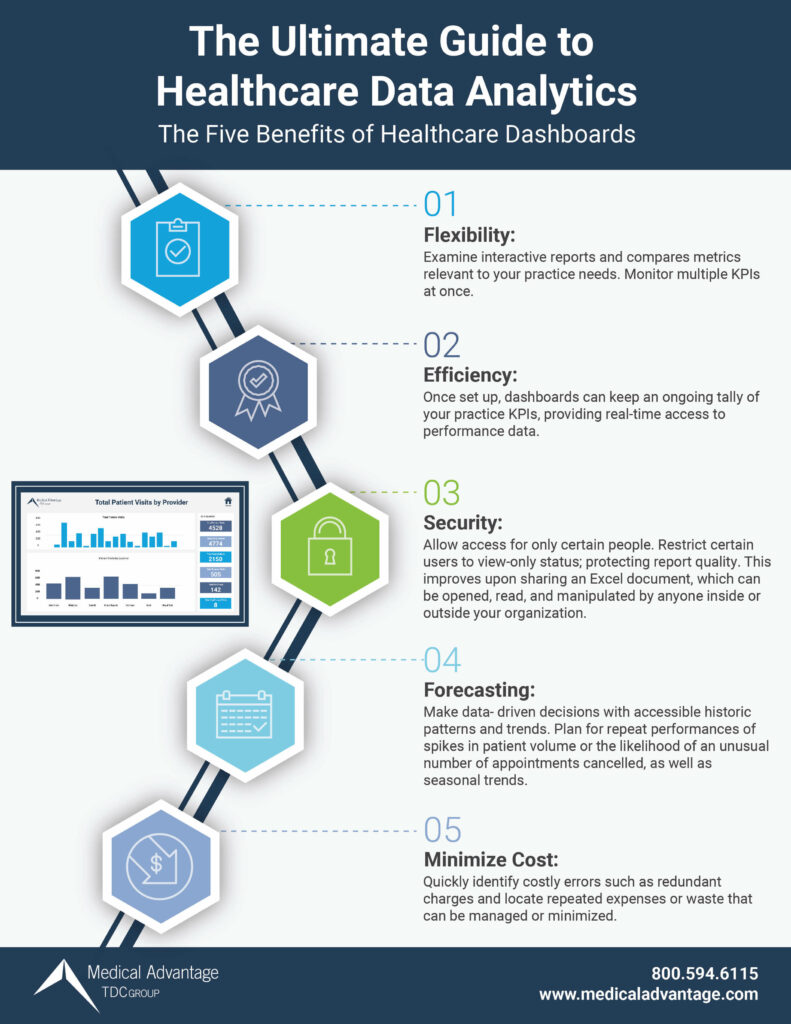What Is Healthcare Analytics? The Ultimate Data Analysis Guide
Healthcare analytics isn’t just for large organizations and systems. Practices of every size and healthcare specialty can enhance their practice’s revenue by making a small investment in data analytics and reporting dashboards.
The electronic medical record is at the center of every practice and houses critical data on patients; unfortunately, this data is often underused when it comes to maximizing patient health outcomes and practice revenue. Data from EMRs can be integrated with data from other sources (i.e., such as practice management systems, payer files, and more) to create an aggregate view of how well the practice is performing on the overall patient panel. Practice level – population health level analytics and reporting allow for practice leaders to identify patients that require outreach to ensure timely preventive care, identify sub-optimal billing and or coding patterns, and monitor performance on a variety of quality and financial metrics that are key to ensuring a practice’s financial stability. Healthcare analytics provide the insights needed to guide practice operations and inform your decision-making process.
Large and thriving healthcare practices and systems have been investing in data analytics and the tools and needed to monitor performance and drive revenue for years now; until recently, these solutions have been cost prohibitive for small to mid-sized practices. This is no longer the case.
What Is Healthcare Analytics?
“Healthcare analytics refers to the use of vast amounts of collected data to provide organizations with actionable insights,” according to IBM.
Actionable insights, IBM notes, include delivering quicker outcomes by processing complex healthcare data faster, the ability to enact sustainable change by exploring the best methods for progress, and the prudence to mitigate risk by assessing data for clinical improvements.
While access to and use of such healthcare data analysis has long been the domain of big businesses such as IBM, or large health systems, advances in computing, data storage and telecommunications as well as electronic health record software tools have made these tools more easily accessible and expanded the scope of who can use the tools today.
Your practice doesn’t need an incredibly high volume of patients, providers or services to make healthcare analytics a worthwhile investment. Any system can benefit from quick, accurate assessments presented in dynamic reports.
Benefits of Clinical Data Analysis
Another key benefit of healthcare analytics is the use of clinical healthcare data analysis for improving medical office efficiency.
The better informed you are, the better your decisions will be, and that applies to running your practice, too. Healthcare analytics can ensure you’re well informed with data on patient visits, including demographics and frequency, as well as what types of visits and procedures bring people in the door most often. That can help you optimize your practice for your current state and prepare your practice for the future by hiring the right staff to meet forecasted demand and allowing you to plan for the likely reimbursement/revenue generated by the anticipated visits.
Healthcare dashboards examples of these clinical data analytics focus on financial, patient and services data that allow you to track and improve revenue and costs, correct and improve trends on services provided, attract more patients and optimize workflows.
The insights can help you minimize losses from insurance claims and avoid denied claims, improve the quality of care, optimize physician-to-patient ratios to improve patient wait time and patient satisfaction, identify gaps in provider schedules, and optimize time spent caring for patients.
As documenting quality of care becomes more important with the shift to value-based care, data analytics in healthcare provides the documentation necessary to ensure your practice is properly reimbursed for the care you provide. Such measures include information on improving outcomes and quality for patients with chronic conditions. Examples include patient asthma control, long-term diabetes management, and high blood pressure control. Practices understand that it is no longer sufficient to provide the adequate care for reimbursement, but proper documentation and coding needs to be monitored on an ongoing basis to maximize performance in value-based care contracts across all lines of business. Dashboards that monitor such metrics are the key to achieving this goal. The shift to value-based reimbursement is showing no signs of slowing; with the federal government leading the charge and commercial payers following suit.
Simplifying Data Analysis with Healthcare Dashboards
Automated dashboards in healthcare streamline the data analysis tasks discussed thus far, allowing users without data analysis experience to easily view and analyze data in real time while empowering more data savvy users to drill down and explore metrics, as needed.
When customized to a practices’ needs, , healthcare dashboards can provide the data needed to monitor practice operations and inform both operational and clinical decision-making processes to improve patient outcomes, bolster payer contracts performance, align patient appointments with staff, mitigate physician burnout, and enhance revenue across practice operations.
There is more data available in healthcare than ever before however its increasingly complicated to turn this data –sitting in multiple systems—into information and resulting insights. Going from data to insights requires a mix of technical skills across a number of team members given the data’s volume and complexity. The average practice struggles to do these tasks efficiently and on an ongoing basis given their other daily responsibilities.
In an ideal world, a professional data analyst would start with your raw data, collecting, checking and organizing it in visual form. For many practices, this task may well fall to the office manager or another member of your staff.
They’ll often do that collecting and sorting among several data silos – separate caches of information throughout your practice that aren’t linked to your other business systems. Since the data is in a separate location from the main network, management reports are unnecessarily complicated, and information can be duplicated. Examples of silos include payroll systems, scheduling software, and electronic health records, (EHR)s.
Dashboards easily collect data from silos and perform the organization and presentation work for that data automatically. What’s more, they’ll stay in constant contact with the practice’s disparate data silos, updating reports and charts when the information entered in any given spot is updated.
A manager no longer needs to ask for a report from an analyst. Now, that sort of information is available at a manager’s demand – literally at their fingertips if need be.
Benefits of Healthcare Dashboards
Aside from instant accessibility, there are several advantages to using dashboards to integrate your healthcare data: flexibility, report efficiency, better forecasts, and security.
Let’s have a look at those in a little more detail:
Flexibility: You can examine interactive reports and compare metrics that are important to your specific practice needs. You can also monitor multiple key performance indicators – KPIs – at once.
Report efficiency: Once set up, the dashboards will keep an ongoing tally of your key metrics, instantly, providing you real-time access to your performance data.
Security: Dashboards can be set up to allow access to only one person or for as many people as you choose. The additional security benefit is that those with access can view the information but not manipulate the data. This safeguards you from issues you may find with a shared Excel document, which can be opened, read and manipulated by anyone inside or outside your organization and allow them to compromise the quality of the report.
Better forecasting: With your finger on the pulse of your practice in the present, you’re better prepared to begin making plans for the future. Historic patterns and trends make it easy to plan for repeat performances of spikes in patient volume or the likelihood of an unusual number of appointments cancelled, as well as seasonal trends.
Minimize cost: Quickly identify costly errors such as redundant charges and locate repeated expenses or waste that can be managed.

Examples of Data Analysis Dashboards
Financial dashboards track KPIs including charges and payments, claim denials, average days to bill and total charges and payments. Business resources and strategies are easier to effectively manage with these details at your disposal.
Patient dashboards track KPIs including patients by day, by age group, by specialty needed, and total patients. These details provide insight into who your patients are, and how to draw more people like them more to your practice.
Patient visits dashboards track patient visits, average wait time, percentage of no-shows, and the average visits a practitioner in your practice is receiving. Those are good things to know if you aim to improve patient care and maximize efficiency.
Services healthcare dashboards track services provided by day, year and quarter. You can also view them by level of demand and revenue generated. If patients are visiting for one service more than others, you might want to shift more staff to support that. You may also want to market high revenue services to bring in more visits for that specialty.
Dashboard reach beyond EHR
Medical Advantage dashboard solutions are also very effective at presenting data from practice sources beyond EHR in Accounting, Human Resources, Payer, Pharmacy, Call Center, and Marketing.
Combining this disparate data, with benchmarking to assist healthcare leaders to make decisions, provides still further insights into a practice.
These data analysis dashboards provide an instant, detailed and interactive look at the financial and medical health and success of a practice. The tools are a necessity for any modern practice that not only wants to keep up with the competition, but also gain quick insights into what makes your practice stand out from the others. With that information in hand, you can act on advantages you might not have realized you had. You can also discover problems before they snowball into larger and more costly issues.
Medical Advantage can help
Using healthcare dashboards to improve medical office efficiency and improve patient outcomes is a big task, even though the software tools are doing much of the work. This is where Medical Advantage can help.
Our financial, patient, patient visits, and services healthcare dashboards are designed to give your organization the insight necessary to make sound strategic decisions, improve care quality, grow your practice, and boost revenue, and our experts provide the input needed to act on those insights.
Fill out the form below to get in touch with one of our consultants today.





